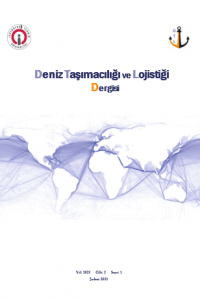Abstract
The continuous growth in world economy, technology, and population still shapes the industrialization patterns. This massive progress have also shaped the international transportation requirements. Ports, as the one of the important infrastructure in international transportation and supply chains, have been pushed by these changes in terms of structuring their capacities to satisfy the demand. This study aims to systematically analyse port capacity literature regarding perspectives of researchers. To do this, this study adopted systematic literature review and content analysis together. Keywords were determined in the study and searched in databases without time limit and the obtained studies classified and evaluated by content analysis to find out the advances of the port capacity domain. Also, the research streams were analysed thematically and future research avenues were provided. The result of this study showed that, the most attracted topics are service level and performance in performance main category; development and planning in “capacity planning” main category; cost and investment topic in “cost and economic analysis” main category; demand and forecasting subcategories in “forecasting and market analysis” main category. Besides, this study suggests future research avenues in port capacity literature
References
- Bassan, S. (2007a) ‘Evaluating Seaport Operation and Capacity Analysis—Preliminary Methodology’, Maritime Policy & Management, 34(1), pp. 3–19. doi: 10.1080/03088830601102725.
- Bassan, S. (2007b) ‘Evaluating Seaport Operation and Capacity Analysis - Preliminary Methodology’, Maritime Policy and Management, 34(1), pp. 3–19. doi: 10.1080/03088830601102725.
- Bichou, K. (2013) Port Operations, Planning and Logistics, Informa Law from Routledge. doi: 10.5399/osu/jtrf.49.3.2606.
- Elo, S. and Kyngäs, H. (2008) ‘The Qualitative Content Analysis Process’, Journal of Advanced Nursing, 62(1), pp. 107–115. doi: 10.1111/j.1365-2648.2007.04569.x.
- Frankel, E. G. (1987) Port Planning and Development. Canada: A Wiley-Interscience Publication.
- Gaur, P., Pundir, S. and Sharma, T. (2011) ‘Ports face inadequate capacity, efficiency and competitiveness in a developing country: Case of India’, Maritime Policy and Management, 38(3), pp. 293–314. doi: 10.1080/03088839.2011.572700.
- Gulmez, S. (2019). Developing a Model for Measuring the Capacity of Dry Bulk Ports in Turkey. Dokuz Eylul University, Institute of Social Sciences. (Doctoral Thesis):İzmir
- Krippendorff, K. (2004) Content Analysis: An Introduction to Its Methodology. Second Edi, Sage Publications. Second Edi. California: Sage Publications. doi: 10.1103/PhysRevB.31.3460.
- Luo, M., Liu, L. and Gao, F. (2012) ‘Post-entry container port capacity expansion’, Transportation Research Part B: Methodological. Elsevier Ltd, 46(1), pp. 120–138. doi: 10.1016/j.trb.2011.09.001.
- Morales-Fusco, P., Saurí, S. and Spuch, B. (2010) ‘Quality Indicators and Capacity Calculation for RoRo Terminals’, Transportation Planning and Technology, 33(8), pp. 695–717. doi: 10.1080/03081060.2010.527179.
- Park, N. K., Yoon, D. G. and Park, S. K. (2014) ‘Port Capacity Evaluation Formula for General Cargo’, The Asian Journal of Shipping and Logistics, 30(2), pp. 175–192. doi: 10.1016/j.ajsl.2014.09.003.
- QSR International. “What is NVIVO”. Access Date 30.01.2021. Available at: https://www.qsrinternational.com/nvivo/what-is-nvivo
- Seuring, S. and Gold, S. (2011) ‘Conducting Content-Analysis Based Literature Reviews in Supply Chain Management’, Supply Chain Management: An International Journa, pp. 544–555. doi: 10.1108/13598541211258609.
- Souf-Aljen, A. S. et al. (2016) ‘Port capacity forecasting and the impact of the dredging works on port sea operations using discrete event simulation’, Jurnal Teknologi, 78(9–4), pp. 31–40. doi: 10.11113/jt.v78.9692.
- Weber, R. (2011) ‘Basic Content Analysis’, Basic Content Analysis. doi: 10.4135/9781412983488.
- Zenzerović, Z., Vilke, S. and Jurjević, M. (2011) ‘Queuing Theory in Function of Planning the Capacity of the Container Terminal in Port of Rijeka’, Pomorstvo-Scienctific Journal of Maritime Research, 25(1), pp. 45–69. Available at: http://www.scopus.com/inward/record.url?eid=2-s2.0-79960526390&partnerID=40&md5=e86abdcafed8cb835adb5811db10af60.
Abstract
References
- Bassan, S. (2007a) ‘Evaluating Seaport Operation and Capacity Analysis—Preliminary Methodology’, Maritime Policy & Management, 34(1), pp. 3–19. doi: 10.1080/03088830601102725.
- Bassan, S. (2007b) ‘Evaluating Seaport Operation and Capacity Analysis - Preliminary Methodology’, Maritime Policy and Management, 34(1), pp. 3–19. doi: 10.1080/03088830601102725.
- Bichou, K. (2013) Port Operations, Planning and Logistics, Informa Law from Routledge. doi: 10.5399/osu/jtrf.49.3.2606.
- Elo, S. and Kyngäs, H. (2008) ‘The Qualitative Content Analysis Process’, Journal of Advanced Nursing, 62(1), pp. 107–115. doi: 10.1111/j.1365-2648.2007.04569.x.
- Frankel, E. G. (1987) Port Planning and Development. Canada: A Wiley-Interscience Publication.
- Gaur, P., Pundir, S. and Sharma, T. (2011) ‘Ports face inadequate capacity, efficiency and competitiveness in a developing country: Case of India’, Maritime Policy and Management, 38(3), pp. 293–314. doi: 10.1080/03088839.2011.572700.
- Gulmez, S. (2019). Developing a Model for Measuring the Capacity of Dry Bulk Ports in Turkey. Dokuz Eylul University, Institute of Social Sciences. (Doctoral Thesis):İzmir
- Krippendorff, K. (2004) Content Analysis: An Introduction to Its Methodology. Second Edi, Sage Publications. Second Edi. California: Sage Publications. doi: 10.1103/PhysRevB.31.3460.
- Luo, M., Liu, L. and Gao, F. (2012) ‘Post-entry container port capacity expansion’, Transportation Research Part B: Methodological. Elsevier Ltd, 46(1), pp. 120–138. doi: 10.1016/j.trb.2011.09.001.
- Morales-Fusco, P., Saurí, S. and Spuch, B. (2010) ‘Quality Indicators and Capacity Calculation for RoRo Terminals’, Transportation Planning and Technology, 33(8), pp. 695–717. doi: 10.1080/03081060.2010.527179.
- Park, N. K., Yoon, D. G. and Park, S. K. (2014) ‘Port Capacity Evaluation Formula for General Cargo’, The Asian Journal of Shipping and Logistics, 30(2), pp. 175–192. doi: 10.1016/j.ajsl.2014.09.003.
- QSR International. “What is NVIVO”. Access Date 30.01.2021. Available at: https://www.qsrinternational.com/nvivo/what-is-nvivo
- Seuring, S. and Gold, S. (2011) ‘Conducting Content-Analysis Based Literature Reviews in Supply Chain Management’, Supply Chain Management: An International Journa, pp. 544–555. doi: 10.1108/13598541211258609.
- Souf-Aljen, A. S. et al. (2016) ‘Port capacity forecasting and the impact of the dredging works on port sea operations using discrete event simulation’, Jurnal Teknologi, 78(9–4), pp. 31–40. doi: 10.11113/jt.v78.9692.
- Weber, R. (2011) ‘Basic Content Analysis’, Basic Content Analysis. doi: 10.4135/9781412983488.
- Zenzerović, Z., Vilke, S. and Jurjević, M. (2011) ‘Queuing Theory in Function of Planning the Capacity of the Container Terminal in Port of Rijeka’, Pomorstvo-Scienctific Journal of Maritime Research, 25(1), pp. 45–69. Available at: http://www.scopus.com/inward/record.url?eid=2-s2.0-79960526390&partnerID=40&md5=e86abdcafed8cb835adb5811db10af60.
Details
| Primary Language | English |
|---|---|
| Subjects | Maritime Engineering (Other) |
| Journal Section | Research Articles |
| Authors | |
| Publication Date | February 18, 2021 |
| Published in Issue | Year 2021 Volume: 2 Issue: 1 |


